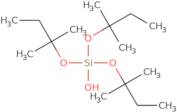Silicic acid (H4SiO4), tris(1,1-dimethylpropyl) ester
CAS: 17906-35-3
Ref. 3D-SAA90635
| 5g | Descatalogado | ||
| 10g | Descatalogado | ||
| 25g | Descatalogado | ||
| 50g | Descatalogado | ||
| 100g | Descatalogado |
Información del producto
- Silicic acid (H<sub>4</sub>SiO<sub>4</sub>), tris(1,1-dimethylpropyl) ester
- Tri-T-Pentoxysilanol
- Tris(1,1-Dimethylpropyl) Hydrogen Orthosilicate
- Tris(2-methyl-2-butoxy)silanol
- Tris(tert-pentyloxy)silanol
- tert-Pentyl alcohol, triester with silicic acid (H<sub>4</sub>SiO<sub>4</sub>)
Silicic acid is a linear polysiloxane with the chemical formula H4SiO4. It is a colorless, odorless crystalline solid that has two allotropic forms: alpha and beta. Alpha-silicic acid is stable in air, but beta-silicic acid converts to silicon dioxide at temperatures above 800°C. Silica can be found in many natural materials such as sandstone, granite, and flint. This material is also used as an additive in many products including paints, adhesives, and sealants. Silica (SiO2) is a major component of glass fiber insulation and sandpaper.
Silica can be synthesized from silicon tetrachloride or by heating potassium dichromate with sodium silicate solution. The most common way to produce silica for use in industry is through the sol-gel process. In this process, water is mixed with a catalyst to form an alkaline solution which reacts with silicon





